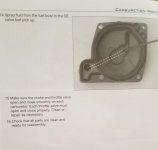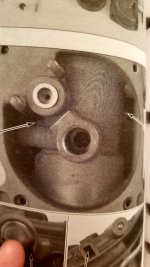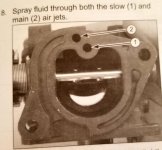Symptoms:
Very hard cold start. The only way I can get it to fire at all is to push up on the diaphragm to squirt a little fuel in, it will cycle a few times and die. If i repeat this I can feather the throttle up to high RPM. The only way I can get to idle is to turn the idle up to 1400 rpm and get the engine warm. This takes a TON of cranking, a 15 to 20 minute ordeal. As it warms up it will idle better and I can lower the idle setting if I keep the engine hot
While idling at 1400, if I pull the top cylinder spark plug cap off, nothing happens, no change. If i pull the middle cap, a very slight dip in RPM. If i pull the bottom, engine stops dead.
Spark plugs are brand new
Engine runs GREAT at high rpm. If i can feather the throttle up while in gear it pushes me 22 knots in a 13 whaler no problems
Work done so far:
Complete carburetor rebuild. Ive had all three carburetors apart to replace gaskets, o-rings, needles and even replacement of the carburetor pilot jets themselves. Of course I cleaned the main jets and carb bowls.
The carburetor tubing confuses me. I have them connected right according to the diagram but it just doesnt really make sense. According the the tubing diagram theres a fuel side and an air side. On each side the 3 carbs are daisy chained together and then drain out the cowling. On each side, the bottom three-way has a connected that isnt used? Diagram here https://www.hondapartsnation.com/oemparts/a/hma/50955f4ff87002378814c37b/carburetor-tubing
I've adjusted the mixture screws to 2 1/4 turns out as per the manual
I've replaced the Bystarter assembly, didnt seem to have any effect. The new one gets very hot.
I've checked valve timing and cam and flywheel lines up according to the manual
Fresh gasoline with Sta-bil and piston ring additive. Have taken Racor out for the moment and only using small inline filter which is new.
Very hard cold start. The only way I can get it to fire at all is to push up on the diaphragm to squirt a little fuel in, it will cycle a few times and die. If i repeat this I can feather the throttle up to high RPM. The only way I can get to idle is to turn the idle up to 1400 rpm and get the engine warm. This takes a TON of cranking, a 15 to 20 minute ordeal. As it warms up it will idle better and I can lower the idle setting if I keep the engine hot
While idling at 1400, if I pull the top cylinder spark plug cap off, nothing happens, no change. If i pull the middle cap, a very slight dip in RPM. If i pull the bottom, engine stops dead.
Spark plugs are brand new
Engine runs GREAT at high rpm. If i can feather the throttle up while in gear it pushes me 22 knots in a 13 whaler no problems
Work done so far:
Complete carburetor rebuild. Ive had all three carburetors apart to replace gaskets, o-rings, needles and even replacement of the carburetor pilot jets themselves. Of course I cleaned the main jets and carb bowls.
The carburetor tubing confuses me. I have them connected right according to the diagram but it just doesnt really make sense. According the the tubing diagram theres a fuel side and an air side. On each side the 3 carbs are daisy chained together and then drain out the cowling. On each side, the bottom three-way has a connected that isnt used? Diagram here https://www.hondapartsnation.com/oemparts/a/hma/50955f4ff87002378814c37b/carburetor-tubing
I've adjusted the mixture screws to 2 1/4 turns out as per the manual
I've replaced the Bystarter assembly, didnt seem to have any effect. The new one gets very hot.
I've checked valve timing and cam and flywheel lines up according to the manual
Fresh gasoline with Sta-bil and piston ring additive. Have taken Racor out for the moment and only using small inline filter which is new.




